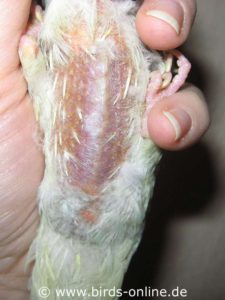Breast

A bird’s breast can tell a skilled observer a lot about a bird’s nutritional status and flight abilities. In order to understand how to gain information from the appearance of a bird’s breast, one should be familiar with the way how this part of the body is built.
At the bird’s breast, there is a large bone, which is called breastbone. The scientific name is sternum. Its cross-section looks a bit like a three-pointed star. A particularly long extension of the sternum points to the front and thus virtually points out of the bird’s body. It is called keel (carina or crista sterni). The wing muscles are attached to the sides of the sternum and they stretch across the bird’s chest. How the keel looks like in the bird’s skeleton can be seen on Wikipedia.
Veterinarians or experienced bird owners palpate the keel when they want to check a bird’s nutritional status. If a bird is fed normally and is a strong flyer, the keel is barely palpable. This is because of the strong wing muscles and a healthy amount of body fat. On the other hand, a bird whose nutritional status is poor usually has less body fat.
Especially birds who are generally unable to fly or who didn’t fly for a longer period due to illness, usually also show a weakening of the flight muscles. In those birds, the keel is palpable as a sharp edge. It’s the same in nearly starved birds. In some cases, the keel is easily visible if one carefully strokes the feathers to the side.
The illustration on this page shows a Linneolated Parakeet who laid on its belly most of the time due to its blindness and old age. Therefore the feathers dropped out and the keel was visible. If you have a close look, you can spot the muscles through the skin on the right and left side of the keel. The wing muscles were quite weak because the bird had not flown for a long time due to being blind.
Overweight can also be identified by having a look at a bird’s breast: If pet birds are overweight, the keel is hardly or not at all palpable. A thick layer of fat covers the keel like a sort of padding.
